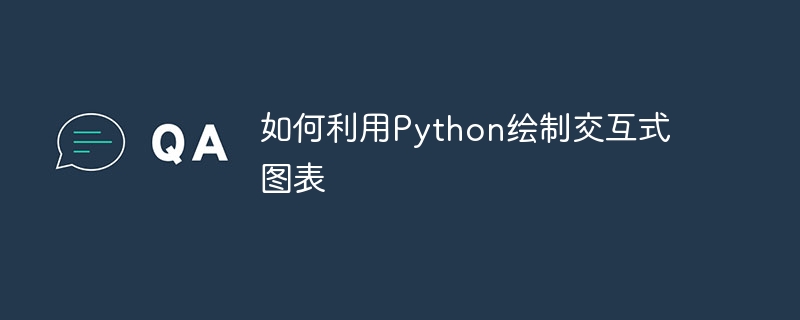Home >Backend Development >Python Tutorial >How to draw interactive charts using Python
How to draw interactive charts using Python
- 王林Original
- 2023-09-28 16:54:321868browse

How to use Python to draw interactive charts
Introduction: Python is a powerful programming language that is widely used in the fields of data analysis and visualization. When it comes to data visualization, Python provides a variety of libraries and tools, the most popular of which are Matplotlib and Bokeh. This article will introduce how to use these two libraries to draw interactive charts and provide specific code examples.
1. Matplotlib library
Matplotlib is one of the most commonly used data visualization libraries in Python and supports drawing various types of static charts. It can draw a variety of chart types such as scatter charts, line charts, bar charts, pie charts, etc., and supports custom settings for charts.
- Install the Matplotlib library
Before using Matplotlib, you need to install the library. It can be installed using the pip package manager with the following command:
pip install matplotlib
- Drawing a static chart
The following is a simple example showing how to draw a simple polyline using Matplotlib Figure:
import matplotlib.pyplot as plt
# 创建x轴和y轴的数据
x = [1, 2, 3, 4, 5]
y = [2, 4, 6, 8, 10]
# 绘制折线图
plt.plot(x, y)
# 添加图表标题和轴标签
plt.title("折线图示例")
plt.xlabel("x轴")
plt.ylabel("y轴")
# 显示图表
plt.show()In this example, the matplotlib.pyplot module is first imported and the x-axis and y-axis data are created. Then, the line chart was drawn using the plt.plot() function. Then use the plt.title(), plt.xlabel() and plt.ylabel() functions to add the title and axis labels of the chart. Finally, use the plt.show() function to display the chart.
- Add interactive functionality
To convert a Matplotlib chart into an interactive chart, you can use the IPython interactive console, or run the code in a Jupyter Notebook. In an interactive environment, you can use some magic commands to manipulate charts.
First, you need to set the interactive mode of the Matplotlib library. Interactive mode can be enabled using the following command:
%matplotlib notebook
Then, make the chart interactive by adding the following command before drawing the chart:
import matplotlib.pyplot as plt
# 创建x轴和y轴的数据
x = [1, 2, 3, 4, 5]
y = [2, 4, 6, 8, 10]
# 创建一个Figure对象和一个Axes对象
fig, ax = plt.subplots()
# 绘制折线图
line, = ax.plot(x, y)
# 添加图表标题和轴标签
ax.set_title("折线图示例")
ax.set_xlabel("x轴")
ax.set_ylabel("y轴")
plt.show() In this example, use plt. The subplots() function creates a Figure object and an Axes object. The Figure object represents the entire chart, and the Axes object represents a specific subgraph. Then, a line chart was drawn using the ax.plot() method. Next, the chart's title and axis labels were added using the ax.set_title(), ax.set_xlabel(), and ax.set_ylabel() methods.
By using the interactive mode, you can zoom in, zoom out, pan and other operations on the chart. For example, you can use the left mouse button to drag the chart and the scroll wheel to zoom in or out.
2. Bokeh library
Bokeh is a Python library for quickly creating interactive charts and data applications. It supports various interaction methods, such as zooming in, zooming out, panning, selection, etc. Bokeh's feature-rich and flexible API make creating interactive charts easy and intuitive.
- Install the Bokeh library
Before you start using Bokeh, you need to install the library. It can be installed using the pip package manager using the following command:
pip install bokeh
- Drawing an interactive chart
The following is an example of using Bokeh to draw an interactive line chart:
from bokeh.plotting import figure, show # 创建x轴和y轴的数据 x = [1, 2, 3, 4, 5] y = [2, 4, 6, 8, 10] # 创建一个Figure对象 p = figure(title="折线图示例", x_axis_label="x轴", y_axis_label="y轴") # 绘制折线图 p.line(x, y) # 显示图表 show(p)
In this example, first import the figure and show functions. Then, use the figure function to create a Figure object and specify the chart's title and axis labels. Next, use the p.line() method to draw a line chart. Finally, the chart is displayed using the show() function.
By using the Bokeh library, you can add interactive toolbars to charts and customize the behavior of the toolbars. For example, you can add tools such as zoom in, zoom out, reset, save, etc.
Conclusion:
This article introduces two methods of how to use Python to draw interactive charts: using the Matplotlib library and the Bokeh library. Matplotlib is a powerful library suitable for drawing various types of static charts. Bokeh is a flexible and powerful library for creating interactive charting and data applications. By leveraging these two libraries, you can easily create interactive charts and customize them.
I hope this article will help you understand how to use Python to draw interactive charts, and I hope you can further explore this interesting and vast field through practice.
The above is the detailed content of How to draw interactive charts using Python. For more information, please follow other related articles on the PHP Chinese website!

